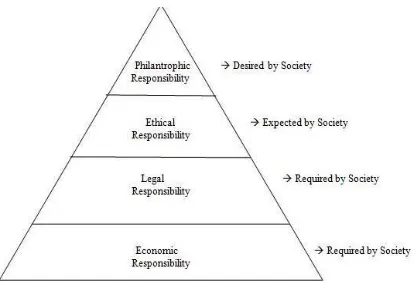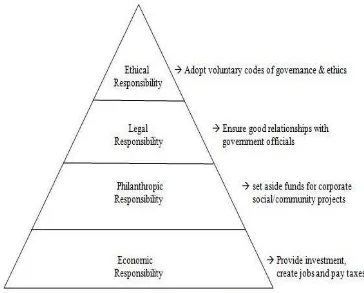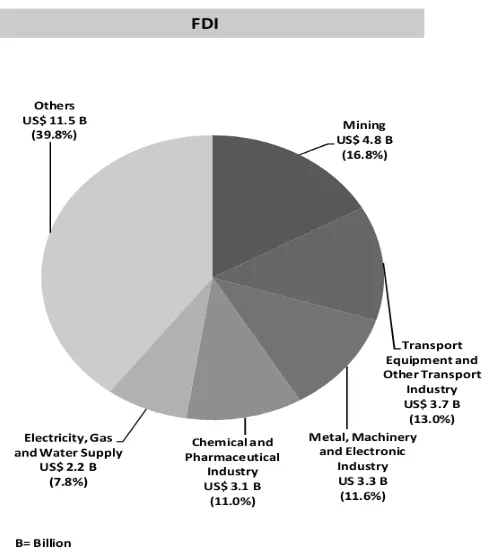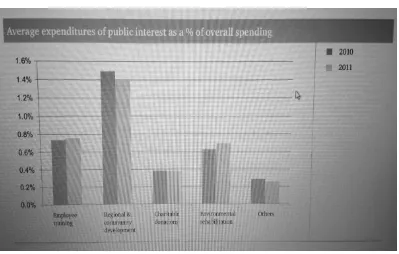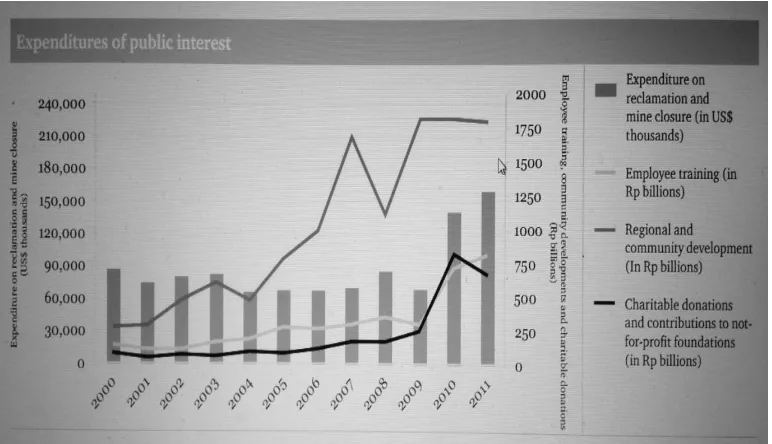111
Multinationals and the Practice of Corporate Social
Responsibility in Developing Countries: Case of Mining Sector in
Indonesia
Erza Killian1
Abstraksi
Keberadaan dan operasi perusahaan multinasional di negara berkembang masih menjadi isu kontroversial. Seiring dengan praktek bisnisnya, perusahaan multinasional menjadi semakin terlibat dalam proses pembangunan suatu negara, termasuk dalam pelaksanaan tanggung jawab sosial perusahaan (corporate social responsibility). Kendati telah banyak studi yang dilakukan terkait CSR, tidak banyak studi yang membahas mengenai model CSR negara berkembang, dikarenakan mayoritas model CSR dikembangkan dari filosofi bisnis model negara maju. Karenanya, tulisan ini bertujuan untuk menjelaskan model CSR negara berkembang dengan melihat salah satu contoh studi kasus yakni praktek CSR yang dilakukan oleh industri tambang di Indonesia. Dengan menggunakan piramid CSR negara berkembang milik Visser, tulisan ini menemukan bahwa praktek CSR tidaklah mungkin untuk hanya digeneralisasi berdasarkan negara maju dan berkembang, karena sifatnya sangat country-specific dan culture-specific. Kendati terdapat beberapa karakteristik yang serupa antara negara-negara berkembang, terdapat beberapa faktor, seperti politik dan sosiokultural, yang sangat berbeda sehingga sangat sulit menghasilkan model CSR negara berkembang yang sifatnya universal. Karenanya, dalam implementasi CSR di negara berkembang, yang harus menjadi perhatian utama adalah elemen politik dan sosiokultural dan bukan hanya fokus pada elemen ekonomi.
Keywords: Corporate Social Responsibility, developing countries, Indonesia, sociocultural element
“What does it mean to say that "business" has responsibilities? Only people can have responsibilities. The social responsibility of business is to
increase its profit”
(Milton Friedman, 1970)
The controversial nature of multinational companies’ (MNCs) existence
and operations in developing countries remains a debatable issue. From a purely economic perspective, foreign direct investment in the form of MNCs can contribute to the capital formation of a country as well as providing employment which can foster the economic growth of a country. On the other side, MNCs
operation can worsen the conditions of a country by creating “sweatshops”, race
112
to the bottom and more controversially, reducing, if not eliminating, the sovereignty of the host country where they operate. However, in major parts of the world, their existence and operations remain intact. Another global trend that follows the operation of MNCs is the growing practice of Corporate Social
Responsibility (CSR), may it be in the form of “socially responsible” actions or
philanthropic activities targeted for the wider community.
Despite the ongoing debate regarding whether business entities should or should not engage in CSR, major firms around the globe can no longer ignore the fact that CSR is becoming increasingly popular and influential. Large global businesses have contributed a large share of their profits to CSR activities. From a business perspective, the ongoing critiques regarding bad businesses’ practices that harm the sustainability of the environment and community has forced them to (re)gain positive image and CSR can provide a tool for this goal. This is also supported by the shift from a state-led development model to a more open and market-oriented development approach, in which private sectors and firms are gaining more space in determining the outcome of an economy. Yet, this progress is not without consequences. The inclusion and growing engagement of firms in the economy means that a mutual relationship should be established between private sector, government and the community itself. This also means that firms are now more responsible in fostering development and therefore can also be held accountable for the (un)development process of a country. As a result, firm-government-society partnership is even more crucial than ever.
Mukherjee-Reed & Reed (2009) offer 4 (four) types of business partnership and involvement which contributes to development, namely (1) conventional business, (2) corporate social responsibility, (3) corporate
accountability and (4) social economy. Each of these models relates to different
113 triangular relationship between government, firm and society which can either be cooperative, conflictual or exploitative in nature. Firms, therefore are confronted with a dilemma on how to maximize their profit and at the same time play their role as an agent of development as is demanded by government and society. Can firms be at the same time accountable to its shareholders and to its stakeholders? Or in other words, is it possible for a firm to be both profit-maximizing and at the same time be responsible?
As a developing country, Indonesia has not yet fully developed a comprehensive regulation regarding the social responsibility of MNCs. Initially, CSR was only made mandatory for state-owned enterprises (SOE) which was then expanded to include foreign direct investment, including MNCs. Currently, there are 2 regulations regarding CSR in Indonesia, namely Undang Undang (UU) No. 40 Thn. 2007 and UU No. 25 Thn. 2007. These laws state that foreign companies operating in natural resources extraction activities should report their contribution to social and environmental responsibilities as development actors in Indonesia. Under this law, CSR is no longer voluntary, but mandatory for foreign companies engaging in natural resource extraction activities in Indonesia. However, this regulation is released by central government with undefined and undetailed explanation at the local level. As a result, not all province in Indonesia has a regulation to follow up these two central laws.
Aside from the legal issues, the amount and form of CSR is also unclear in Indonesia. Consequently, many companies are still clueless in designing sustainable CSR strategy in Indonesia. For example, many CSR programs in Indonesia are merely a response to community and/or government demand to ensure safety operations of the business. However, this kind of short-term strategy may not actually benefit the country since no clear and long-term planning is made. As a result, many CSR programs in developing countries are often costly, inefficient and leads to failure since it lack major considerations of how to ensure sustainability at all levels (business/economic sustainability, social sustainability & environmental sustainability).
114
conducted by mining companies in Indonesia. The findings suggest that the current model of CSR practice lacks considerable consideration of political and sociocultural factors. Furthermore, although several similar traits can be seen in developing countries, CSR practice should be country-specific and culture-specific. This means that developing CSR strategy should not be the sole responsibility of company but should be a collaborative effort between government, company and society. To elaborate these ideas, the paper will be structured into 4 interconnecting parts. The first part will review the literature on CSR practice in developing and developed countries while the second section will discuss a case study on CSR practice of mining company in Indonesia. Third part will present the argument for CSR models in developing countries while the final section will conclude the overall discussion.
MNCs and CSR in Developing Countries
Labelled as “everyone’s favourite monster”, MNC’s operations in developing countries are always controversial. The term “everyone’s favourite monster” encapsulate the love-hate relationship MNCs usually have with their host countries due to several reasons. On one hand, FDI help accumulates capital to the country, stimulates local employment and brings new technology to the country. On the other hand, MNCs can also exhaust the natural resources of the country, can create a crowding-out effect on the local industry and reduce state’s sovereignty. Another controversy regarding MNCs is the fact that until now, there are no global regulation or institutions that regulates the operation of MNCs. The 2 major efforts to regulate MNCs through institutions via the New International Economic Order (NIEO) and Organisation of Economic Co-operation and Development (OECD) have both ended in failure (Balaam & Dillman, 2011). According to Oatley (2007), MNCs currently operate based on 4 principles which are (a) Foreign investments are private property to be treated the same as domestic firms; (b) Governments can expropriate foreign investments, but only for public purpose; (c) Expropriation must be accompanied by compenasation which is
115 that in some cases, host countries are often confronted not only with the MNC itself, but with their home country as well.
The absence of global regulations regarding MNCs causes several misperceptions and also misconduct that further exacerbate host country, MNC
and home country’s relationship. The newest case would be the nasionalisation of
Repsol oil company by the Argentinian government which resulted in an outrage from the Spanish government. This absence of regulation also means that MNCs will only operate in the global regime they know the best, the global market regime. Relying on the forces of the market means that MNCs will behave only if the market forces forced them to do so.
Within the context of market practice, one distinctive global trends have emerged regarding the conduct of MNCs, namely the growing practice of corporate social responsibility. Defining CSR is no easy task since it can encompass any form of socially accepted behaviour and responsibility, ranging from anti-corruption behaviour up to promoting environmentally-friendly and community empowerment programs. In it simplest form, CSR can be defined as the ongoing commitment of business to behave ethically and contribute to economic development, while improving the quality of life of its employees and that of the community which it operates as well as society at large (Institute for Corporate Culture Affairs, 2005). By definition, CSR can be seen as a social commitment done by corporate to ensure that its operations and practices can contribute to the development and welfare of the community. Also in this sense, CSR is an internal-external commitment made by the corporation dedicated to the improvement of their own (internal) behaviour as well as actions that have an impact to the outside (external) parties.
116
Figure 1. Carroll’s (1991) Four-Part Model of Corporate Social Responsibility
Based on Carroll’s four-part model of CSR, it can be seen that CSR should encompass all four responsibilities, where each responsibility differs depending on its position in the pyramid. At the bottom is the standard and conventional responsibility of corporate which are making profit and obeying the rules. The top 2 layers of the pyramid shows the responsibilities that is expected and desired by the society, namely the ethical and philantrophic responsibility. However, this model also has limitations since it does not take into consideration conflicting responsibilities that can occur (Matten, 2006). For example, the threat of plant closure can cause a conflict between economic responsibility (being efficient and making profit) and at the same time ensuring the jobs of the worker (ethical responsibility) (Matten, 2006).
However, not all scholars agree on the social responsibility of corporate. In his highly provocative publication, “The Social Responsibility of Business is to
117 support his argument. First, moral responsibility and moral judgement only belong to individuals/entities and since corporate is not an individual entity, it has no moral obligation to be socially responsible. Second, if corporate does in fact have social responsibility, then it is the individuals within the corporate, such as managers and shareholders that should be socially responsible. The third and last argument is that managers, shareholders and companies are incompetent and incapable of determining what works best for the community or society and hence, should not take any responsibility in providing programs or activities for the community since they are not political actors. As a proponent of neoliberalism, Friedman clearly points out the division and differentiation
between state and market’s role in determing social and economic outcomes
including their highly different social roles. Friedman’s controversial position was then contested by other scholars by pointing out that corporate can also be responsible and at the same time make profit since CSR can actually enhance the competitive advantage of a company.
Despite the widespread practice of CSR by major companies and numerous empirical research on the CSR agenda, little study has been done to differentiate between CSR practice in developed and developing countries (Visser, 2007). Current practice of CSR mostly originated from the philosophy and belief of the northern or developed countries, despite the fact that most of their operations are in developing countries. In his work, “Corporate Social
118
Although theoretically, Corporate Social Responsibility should have a positive impact on development, not all CSR is successfull. Frynas (2005) lists 5 factors contributing to the failures of CSR implementation, namely: country and context specific issues, failure to involve the beneficiaries of CSR, lack of human
resources, social attitudes of company’s staff and the failure to integrate CSR
inititatives into larger development plan. These 5 factors show that managing CSR programs is not as simple as it seems and many factors should be considered to ensure a successful implementation of CSR, particularly in developing countries. Looking at the different characteristics of developing and developed countries, Visser (2007) re-formulated Carroll’s CSR pyramid that better captures the situation of the developing world.
Figure 2. Visser’s (2007) CSR Pyramid for Developing Countries
Visser (2007) differ from Carroll (1991) in the ordering of the
119 important than other responsibilities. However, this pyramid does not prescribe what companies should do, but rather shows how the real practices of CSR in
developing countries are. Visser’s work highly focused on the different cultural factors that shaped the relationship between MNCs and developing countries.
From a political perspective, Newell (2005) highlights the (un)accountability of CSR practice in developing countries. Newell sees that most CSR practice from major firms in developing countries is based only on the codes of conduct of the company itself and no measures or regulations is available for
companies that are ‘irresponsible’ in their practice. Furthermore, Newell (2005)
sees there is an unequal distribution of power between large, foreign firms with poor, traditional society in developing countries, causing the unaccountability and irresponsibility of MNCs. This situation is worsened by the fact that most operations of MNCs are usually in the poor area of the country, where politically these areas are already underrepresented and politically marginalised by the central government (Newell, 2005). Hence, it can be seen that, generalising the practice of CSR in developed and developing countries can lead to several pitfalls in both the study and conduct of CSR.
Case Study: Mining Sector and Its CSR Practice in Indonesia
120
Figure 3. Indonesia (Foreign) Investment Realization Based on Sector (Jan-Dec 2013)
Source: Indonesia Investment Coordinating Board (2013)
Aside from its large FDI share, mining sector also contributes siginificantly for Indonesian economic growth. Bank Indonesia (2013) reported that mining sector accounts for 5 to 6% of Indonesian GDP in 2011 and 2012 and contributes more than 17% of Indonesia’s total export revenues. This number shows the economic importance of mining industry on Indonesian economy. Furthermore, due to Indonesian regulation, CSR for mining industries is no longer voluntary, but mandatory. However, despite this regulation, acquiring complete data regarding practice and funding of CSR activities in Indonesia is still difficult. Several large companies report their CSR and sustainability practice annually, while other companies do not provide public report. In 2005, only one company provides their CSR Report (referred to as Sustainability Report) while in 2012, forty companies provide this report (National Center for Sustainability Reporting, 2013). However, this number is a miniscule compared to the number of foreign direct investment (FDI) and MNCs in Indonesia.
Folowing Indonesia’s regulation regarding mandatory CSR for mining
121 major mining companies in Indonesia. Although accurate data regarding CSR is
difficult to find, data on companies’ expenditure for public interest can be found.
Expenditure for public interest can be loosely defined as any type of spending that relates to the needs of community, including CSR expenditure. The types of activities for public interest are classified into 4 (four) categories, namely employee training, regional & community development, charitable donations and environmental rehabilitation. Below is the allocation for each type of activity compared to the overall spending of the mining company.
Figure 4. Mining Sector’s Average Expenditure of Public Interest as a Percentage of Overall Spending (2010-2011)
Source: 11th Annual Review of Trends in the Indonesian Mining Industry (2013)
Based on the graph, it can be seen that there has been a slight decrease in the expenditure of regional & community development and charitable donations in 2011 and an increase on environmental rehabilitation and employee training spending. This means that from 2010 to 2011, the increase in spending for public
interest mostly goes to the companies’ internal interest, such as increasing the
quality of worker and maintaining good natural environment for the sake of
122
spending and not for a specific focus on certain public’s interest (PricewaterhouseCoopers, 2013). Aside from the spending amount, one also needs to look at the allocation of CSR funding by companies. Below is the distribution of CSR expenditure by mining companies in Indonesia.
Figure 5. Mining Sector’s Expenditure of Public Interest (2000-2011)
Source: 11th Annual Review of Trends in the Indonesian Mining Industry (2013)
As seen in the graph, the largest share of spending goes to regional & community development and reclamation & mine closure (classified as environmental rehabilitation). This is a constant trend from 2000 up to 2011. On the other side, employee training and charitable donations account for the smallest portion of spending. This means that most CSR funds by mining companies in Indonesia are channelled to assist development and protect the environment.
With regards to the CSR pyramid, this allocation of CSR spending can also be used to identify the pattern of CSR activities in Indonesia. CSR Pyramid identifies 4 types of responsibilities namely legal, economic, philanthropic, and
123 can not be easily applied to Indonesia due to several reasons. First, CSR is mandatory by law in Indonesia and hence, for the case of Indonesia the bottom pyramid for CSR would be legal responsibility. However, this is also problematic since Indonesia has a weak law enforcement, including in taking legal actions to punish companies who did not conduct CSR activities. As a result, although on legal accounts (de jure), CSR is a legal responsibility at the bottom of the pyramid, on actual accounts (de facto)¸ CSR as a legal responsibility may not always lie on the bottom of the pyramid. Second, philantropic and economic responsibilities are blurred in the context of Indonesian CSR. For example, CSR activities of PT Freeport Indonesia2 includes providing job for local Indonesian,
and more specifically Papuan3 people. In this sense, providing jobs and developing the local community is a unitary action and can not be easily separated as an economic or a philanthropic responsibility. This is also the case for many mining companies in Indonesia where society requires them to provide jobs for local community. Consequently, Visser’s CSR model/pyramid for developing countries may not apply for CSR practice in Indonesia since in practice, CSR is highly country-specific and culture-specific.
Factors Affecting CSR Practice in Developing Countries
Practice of CSR in developing and developed countries are clearly distinct. However, these distinctions are not only because of their different development levels, but also due to other factors such as politics, society and culture. We will discuss each factors in turn. In terms of politics, 2 (two) crucial factors need to be considered. First, in terms of politics, the practice of CSR should never be a
substitute for government’s role and responsibility. CSR should act as a
complement, not a substitute for government’s programs. In developing countries, government have limited resources and require additional funding from various
resources including multinational companies. However, MNCs are government’s
2 PT. Freeport Indonesia is an affiliation of US-based Freeport McMoran Inc, the largest copper mining company in the world.
124
partner and should not act as a “buffer” between government and its citizen. Government should not transfer their responsibility to private sector since private sector does not have the competence and capacity to determine the appropriate government programs. However, this is apparent in several CSR cases, including Indonesia.
The second consideration is regarding the governance of CSR practice in developing countries. As Newell (2005) has argued, operations of MNCs are usually in the least advantaged area which already puts the people and region politically disadvantaged. This is particularly true for the case of Freeport Indonesia or PT. Newmont Nusa Tenggara4 which operate in two of the poorest
region in Indonesia. As a result, unproper MNCs operation and misconduct of CSR puts the community at an even more disadvantaged position. It is therefore, important to take into account the large gap between central and local government in developing countries. Many developing countries adopt a decentralised system of governance, but still needs to work on perfecting it. For example in Indonesia, after more than a decade of decentralised government system, central-local government gap is still high. Several province such as Papua (Freeport
Indonesia’s area of operation), were given special autonomy status but was
subsequently rejected by the local community. With regards to MNC and CSR practice, company and government needs to develop a multilevel governance of CSR, both horisontally and vertically. Vertically in terms of cooperation between local and central government and horisontally between companies, government and other stakeholders. Without developing a multilevel system of governance for CSR, the positive impact of CSR can not be felt by the larger community.
Aside from its political elements, conduct of CSR also need to consider the sociocultural elements of the country. Frynas (2005) has suggested the inclusion of culture and social identity in the conduct of CSR since eliminating these elements will result in the failure of CSR. However, culture and sociocultural elements have a relatively large spectrum. Which elements of culture should one take into account when conducting CSR? To answer this, one needs to look at models or framework of culture. Models and framework of culture has
4 PT. Newmont Nusa Tenggara is a subsidiary company of US-based Newmont Mining
125 been widely studied in business practice although not much can be found on the implementation of these frameworks on CSR practice. The most popular cultural
framework is perhaps Geert Hofstede’s Cultural Framework which categorizes
culture based on 6 dimensions, namely power distance, individualism versus collectivism, masculinity versus femininity, uncertainty avoidance, pragmatic
versus normative and indulgence versus restraint (Hofstede, 2010). These 6 dimensions has 6 broad spectrums and is used to determine the cultural traits of each country. This framework has been widely used in the practice of international marketing, international communication as well as global business. Although this framework has limitations, it can be used as an initial guideline in developing CSR programs which is appropriate for specific culture. Furthermore, it also gives preliminary picture of the society where the business operates. However, it should also be noted that there are also sub-cultures within a country or community, and hence overgeneralisation can also be problematic. Several developing countries are highly homogenous while others are relatively heteregenous (such as Indonesia). Therefore, developing CSR strategy must also consider the different characteristics of developing countries while also trying to single out the similar one.
In sum, developing a general model of CSR for developing countries is an elusive task, since CSR is highly country-specific and culture-specific. The general CSR pyramid depicts a good model of CSR based on their responsibility but is inadequate to explain the change in each responsibilities as well as take into account different cultural values (for example what is considered as ethical responsibilities by one country may be considered as philanthropic responsibilities by another). Therefore, cultural values needs to be included to achieve a more comprehenesive model of CSR. Lastly, with regards to development, MNCs and their practice of CSR should also be included in the process and they should also be given the responsibility. However, like every other actors, MNCs responsibility is limited. It is limited by the responsibility of others actors such government and community and is also limited by its own capacity. Hence, the question is not whether MNCs should or should not engange in CSR, but the exact question
126
Conclusion
Development process requires simultaneous and collaborative efforts from various actors, including private sectors. The widespread operation of multinational companies and the popular practice of corporate social responsibility has profound consequences for countries, particularly developing ones. Due to different conditions, CSR practice in developing and developed countries should be differentiated. This distinction is crucial since large business operations who engaged in CSR usually adopts western approach and does not take into consideration the differing values of the developing world. However, despite several similar characteristics, it can be misleading to generalise the whole developing world. This overgeneralisation can lead to the failure of CSR practice and can worsen the relationship of MNC, government and society. Therefore, the conduct of CSR in developing countries needs to consider two important and interrelating elements namely the politics and governance of CSR in the country and the sociocultural aspect of the community.
BIBLIOGRAPHY
Balaam, D.N & Dillman, B. 2011. “Introduction to International Political Economy”, 5th Edition, Pearson
Banerjee, S.B. 2007. Corporate Social Responsibility: the Good, the Bad and the Ugly, Cheltenham, Edward Elgar
Friedman, T. 1970. “The Social Responsibility of Business is to Increase Its Profits” in The New York Times Magazine. The New York Times Company
Hennigfeld, J, Pohl, M. & Tolhurst, N. (eds). 2006. The ICCA Handbook on Corporate Social Responsibility. West Sussex. John Wiley & Sons, Ltd.
Hofstede, G. 2010. Cultures and Organisations: Software of the Mind. 3rd Edition. McGraw-Hill
Matten, D. (2006). “Why do Companies Engage in Corporate Social Responsibility? Background, Reasons and Basic Concepts” in The ICCA Handbook on Corporate
Social Responsibility. West Sussex. John Wiley & Sons, Ltd.
Oatley, T. (2007). International Political Economy: Interests and Institutions in the Global Economy. Pearson Longman
PricewaterhouseCoopers. (2013). 11th Annual Review of Trends in the Indonesian
127
Journal
Carroll, A.B. 1991. “The Pyramid of Corporate Social Responsibility: Toward the Moral
Management of Organizational Stakeholders” in Business Horizons July-August 1991
Frynas, J, G. 2005. “The False Developmental Promise of Corporate Social Responsibility: Evidence From Multinational Oil Companies” in International Affairs 81 No. 3: 581-598
Gugler, P & Shi, J.Y.J. 2009. “Corporate Social Responsibility for Developing Country
Multinational Corporations: Lost War in Pertaining Global Competitiveness” in Journal of Business Ethics, 87: 3-24
Indonesia Investment Coordinating Board 2014. Domestic and Foreign Direct Investment Realization in Quarter IV and January-December 2013
Mukherjee-Reed, A. & Reed, D. (2009). “Partnership for Development: Four Models of
Business Involvement” in Journal of Business Ethics, 90: 3-37
Newell, P. (2005). “Citizenship, Accountability and Community: the Limits of the CSR Agenda” in International Affairs, 81 No. 3: 541-557
Visser, W. (2007). “Corporate Social Responsibility” in Corporate Social Responsibility
in Global Context
Weyzig, F. (2009). “Political and Economic Arguments for Corporate Social
Responsibility: Analysis and a Proposition Regarding the CSR Agenda” in Journal of Business Ethics, 86: 417-428
Website
Infomine Mining Intelligence & Technology 2014. Indonesia Mining Companies. <http://www.infomine.com/countries/indonesia.asp> (accessed on April 14th, 2014)
National Center for Sustainability Reporting (2014). Sewindu Penghargaan Sustainability Reporting (Laporan Keberlanjutan) di Indonesia dan Kini Merambah ke Asia
